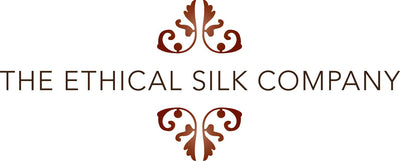The Secret Of Sericulture
This week on the #EthicalSilkCo Blog we decided to delve deeper into how silk has been made throughout history. The term sericulture is used to describe the process of creating silk garments and fabric from the raw fibres created by silk worms. For thousands of years, the Chinese had a monopoly on the production of silk and guarded their secrets of sericulture very closely.
In one of our previous blog posts, we examined the rich history behind silk and found that it originated in China. The Yellow Emperor’s wife, Lady Hsi-Ling-Shih, is credited with the creation of silk production around 3,000BC. Silk was a highly prized and valued fabric even in its early inception, with only the higher classes of society being granted access to the material. It’s therefore no surprise to find that the Chinese sought to protect their new found economic gem, resulting in sericulture becoming a closely monitored and almost secret art.

Silk has been beautifully crafted by the Chinese for thousands of years
As you can imagine, producing silk is a lengthy process and demands certain skills. To produce high quality silk, two conditions were necessary; perfecting the diet on which the silkworms would feed and also preventing the moth from hatching. The Chinese developed covert methods for both. Temperature was a key element - eggs began incubation at 65ºF (18.3º Celsius), gradually increasing to a balmy 77ºF (25ºC). At this stage, the eggs would hatch and the infant worms would feed every 30 minutes on fresh Mulberry leaves. These worms would be stored in trays by the thousands and stacked on top of each other. In less than one month, these worms would reach an astonishing 10,000 times their original weight! In addition the worms would change colour and shed their skin several times.

Having reached this milestone, the silkworms would have accumulated enough energy to enter into the ‘cocoon stage’. The worms produce a jelly-like substance which hardens when it comes into contact with air. This material is designed to protect the growing silk worm from drafts, noises and strong odours. The silk worms typically take between three and four days to construct their cocoon until their appearance resembles white puffy balls of fibres. With temperature conditions adequate for the silk worms, the Chinese would leave them for approximately eight to nine days, before beginning the extraction process.

Mulberry Silk cocoons
First the worms were steamed to kill them, after which the cocoons were placed in hot water to loosen the tightly intertwined fibres. It’s important that we remind our readers that The Ethical Silk Company does not use this process in the production of our silk, instead opting for an animal cruelty-free technique developed by Ahimsa Silk! Each of these filaments are between 600 - 900 meters long and once the final silk threads are woven together, the silk can then be used to produce fine garments.
We have already mentioned how important silk was to the Chinese economy and as a result, Chinese authorities controlled the sericulture secrets with strict rules and regulations. If you were found to have passed on the production secrets, or smuggled silkworms outside of China, you would be punished with the death penalty.

The Imperial Chinese guards were tasked with sericulture’s protection
Consequently, many risked their lives for this lucrative material. In 550, Emperor Justinian appointed two monks to travel to China with the task of stealing the sericulture secrets. These spies were able to smuggle silkworm eggs in a hollow bamboo cane. Soon after, silk production began within Constantinople and the sericulture secret which had been heavily guarded for 3,000 years were finally uncovered. Inevitably, from here the production of silk spread as more nations and empires discovered the practice. Silk was still a hugely valuable commodity and despite losing the secret to others, China remained at the forefront of silk production with its fabric because of its high rated quality.
Nevertheless, silk production spread to other areas around the Middle East and Europe rapidly, but we’ll keep that story for another day. If all this information has made you feel like treating yourself to a luxurious silk garment, don’t forget to check out our online store. You can also follow us on Facebook or Twitter to keep up to date with all our blog’s and latest news!
Thanks,
Eva

